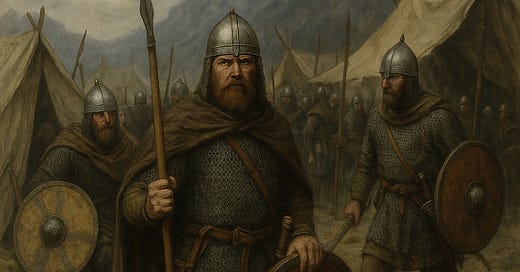The Gruesome Realities of Medieval Hebridean Warfare
The scenic Outer Hebrides of today—with their serene lochs, rolling moors, and whispering sea breezes—offer few visible signs of the bloody centuries that once defined them. Yet, dig beneath the turf of history and you will find a brutal legacy. In the Middle Ages, warfare in the Hebrides was not just common—it was visceral, tribal, and often unspeakably cruel.
Caught between Norse ambitions and Scottish consolidation, these windswept isles were battlegrounds for rival kings, warlords, and clans. From mutilations and child-spearing to floating escapes in barrels, the chronicles of Hebridean conflict read more like grim mythology than recorded history. But they happened.
This blog peels back the romantic veil to examine the darker, more gruesome realities of medieval warfare in the Hebrides—a world where survival often meant savagery.
No Brothers in War: Betrayal and Blinding
Perhaps the most shocking events of Hebridean medieval conflict involved family betrayal. In 1223, a young Norse-Gael prince named Godred Don took refuge on St. Colum's Isle near Skye, only to be attacked by his own uncle, Olave the Black, and a trusted lieutenant, Paul Balkasson.
Though captured alive, Godred’s fate was horrifying. Without Olave’s consent, Balkasson had him mutilated and blinded—an act of both political mutilation and symbolic annihilation. And yet, history records that Godred later reappeared as a “particularly alert, if short-sighted individual,” hinting the blinding may have been partial or symbolic.
Still, this was no isolated case. Mutilation was standard practice in medieval Hebridean warfare. Blinding, castration, and maiming were commonly used to permanently neutralize threats without technically shedding royal blood—a useful loophole in both Norse and Christian ethics.
Barrel Escapes and Baby Spears: Barbarism on All Sides
One of the strangest and most haunting tales involves Tormod MacTorquil, who fled a Norse-led raid by leaping into a floating cask, which drifted across sea and saved his life. The image is almost comedic until contrasted with the horror that prompted his escape.
That same raid, according to chroniclers, saw Torquil MacDermot and his two sons murdered, their household razed. This wasn’t a war of armies; it was personal slaughter.
Even children were not spared. During the 1262 ravaging of Skye by Scottish-supported forces, the atrocities reportedly included child-spearing—a grotesque act where infants were tossed between warriors on spears, a practice disturbingly mirrored in Norse Viking sagas of centuries earlier.
The cruelty wasn’t one-sided. Norse pirates, such as Ruari of Garmoran, were infamous for pillaging coastlines and murdering captives, especially after being stripped of their lands by the Scottish Crown. In one retaliatory campaign, Norwegians captured the wife of an enemy and burned her possessions, sending a clear message: This was personal.
Raiding Culture: Cattle, Captives, and Retribution
In the Hebrides, raiding was not just warfare—it was economics. To lose your cattle was to lose your survival. Cattle raiding, house-burning, and boat-seizing were not crimes—they were statements of dominance. What made warfare so gruesome wasn’t just the violence—it was how closely tied it was to life, land, and lineage.
Boats were burned to trap enemies on islands.
Entire households were abducted or slaughtered.
Possessions, wives, and children were treated as plunder.
This violence was cyclical. A murdered chief would provoke blood vengeance, sometimes across generations. The infamous Siol Torquil (Macleods of Lewis) and their bloody feuds with rival clans offer case after case of endless retaliation.
To ensure future loyalty, conquerors would take hostages, often children, and raise them in their courts—another blend of psychological warfare and medieval realpolitik.
Final Reckonings: Death by Fire and Sea
Punishments for disloyalty or resistance were often final—and theatrical. Paul Balkasson, who blinded Godred Don, was later hunted down and killed, possibly in retribution. His son, Balka, followed the same path, chasing down enemies in Skye and Lewis before finally meeting a violent end himself.
In many cases, burning was the method of execution or revenge. Houses and villages were torched wholesale, with no regard for who might be inside. Fire was symbolic in Norse custom—a purifier and a destroyer. Burning one's property was to erase your name.
One of the most eerie footnotes of this era is the Viking tradition of ship burials and even funeral pyres set adrift at sea—a practice likely witnessed or remembered in Hebridean oral culture. Whether burning the living or the dead, fire remained a constant in Hebridean warcraft.
Final Thoughts: Brutality as Survival
Was Hebridean warfare more brutal than that of mainland Scotland or Scandinavia? Perhaps not in scale, but in intimacy, certainly. These were not anonymous battlefield slaughters. They were personal, often family-on-family. And in an island world where everyone knew everyone else’s ancestry, violence had a name, a face, and usually a motive.
To survive, one had to be cunning, loyal, and merciless. The medieval Hebridean warrior lived in a paradoxical world: one steeped in Christian rites, but still ruled by Odin’s ghosts—blood for blood, honor for insult, death for shame.
The ruins of castles and the silence of now-empty moors cannot hide it. The stones remember.





